Emu Ranch
BUSINESS PLAN
SOUTHWESTERN EMU RANCH
28600 W. Tumbleweed Pass
Canyon, TX 79015
South western Emu Ranch has jumped on the healthy lifestyle bandwagon. The demand for quality, low fat food has created a new market for emu products. Interesting financial information is provided in the form of an Operational Costs Table and Projected Income Statements for the first four years.
- BUSINESS CONCEPT
- MARKETING PLAN
- OPERATIONAL PLAN
- INITIAL START-UP COST
- STRATEGIC PLAN
- FINANCIAL INFORMATION
BUSINESS CONCEPT
The emu is a large bird which originally came from Australia and belongs to the big bird family group known as the ratites, which includes other birds such as the ostrich (found throughout Africa and south western Asia) and the Cassowary (also found in Australia).
The emu ranch will be in the business of "ranching", or raising, emu birds for two main purposes. The first purpose is to raise newly hatched emu chicks to the age of a year or older, pair them off and sell them as good quality adult emu breeding pairs. The second purpose is to raise a portion of these chicks to the age of twelve months or older for the purpose of slaughter for their lean red meat, oil and skin for leather products.
The breeding pairs will be sold nationwide to other emu ranchers, who are established in the business or are just starting. At first, this will be the emu ranch's main target market, because of the high profits that can be made by selling adult emus as breeding pairs.
The emu ranch's secondary market will be the slaughter market, whose main products consist of prime cuts of emu meat, ready for shipments to restaurants, residential orders, worldwide markets and in the future, shipment to supermarkets. High quality leather from the emu's skin, and five to six liters of emu oil, which is currently being used in the cosmetic industry, will also be distributed. Additionally, the medical industry uses the oil for therapeutic rubbing oil, skin and facial moisturizing lotions and medical applications used for treating the skin of burn victims.
The raising of emu birds for breeding pairs or for slaughter is unique, because the emu breeding pairs, when at their peak of producing fertile eggs, will produce at the end of an eighteen month cycle. Between forty five to fifty adult emus will be ready for slaughter or to be sold as breeding pairs at eighteen months to two years old. In other words, one breeding pair will produce more meat and leather in eighteen months than one beef cow breeding pair, not including the amount of high grade oil that forty to fifty adult emus will produce. Each adult emu will produce seven liters of fine organic oil, that is non-allergenic to human skin.
Right now the emu industry is in a breeder's market stage, which means that the nation's emu ranchers are raising and selling their adult emu birds as breeding pairs, instead offer slaughter. There are substantial profits that can be made in raising and selling emus as breeding pairs, given the large volume of emu ranches that are starting each year.
A proven emu breeding pair can be sold at $8,000 to $30,000 depending on the historical number of fertile eggs the pair has produced each mating season. Proven breeding pairs may lay between thirty to fifty fertile eggs per mating season.
Therefore, if the emu ranch started with ten proven breeding pairs that would lay on average thirty-five eggs each, of which, at the end of successfully raising all of the emu chicks to eighteen-months to two-year-old adult emus, the total number of adult emus would be 350. If these are sold at $15,000 per breeding pair, the total gross amount of sales, without the subtraction of the initial start-up costs would be (.5 × 350 × $10,000 = $1,750,000). An example of our secondary target market, would be the current slaughter market which is paying between $500 to $800 for each adult emu bird ready for slaughter. Therefore, 350 × $500 for each adult emu for slaughter is $175,000.
MARKET PLAN
Industry Description and Outlook
The primary target industry of the emu ranch will be the current breeder's market. This means that nearly all of the emu farmers are raising their newborn emus to fully adult breeding pairs and selling them to emu farmers who are just getting started in the business. The current annual growth rate in the number of new or start-up emu farms here in the United States is between four and five thousand, which is the total number of emu farms which existed in 1994. The average number of breeding pairs that each new farm will start with, is between two to eight breeding pairs. Therefore, the average number of breeding pairs needed for 1996 is twenty-four thousand, or forty eight thousand birds. The current emu population in the United States is estimated to be between two hundred fifty thousand and five hundred thousand. The majority of this population is located in Texas.
The secondary target market will be the emu slaughter market. The number of emus required for slaughter annually at a conservative projection is estimated to be between one and a half and two and a half million birds. These projections are expected to increase within the next three to five years. This figure does not include the existing large demand of products that exist within the European markets.
Note: Of the estimated two hundred fifty thousand to five million emu birds that exist here in the United States, only twenty to thirty thousand of these birds are actually laying hens.
The growth potential for emu ranching in the next five years is unlimited, given the above information. Also, the demand for emu products is currently surpassing and will continue in the next five years to surpass emu supply.
The growth potential of emu ranching in the next ten years is projected to be unlimited, given the projections for the number of emus required for slaughter to meet consumer demands both here in the United Stated and in Europe.
Industry Characteristics and Trends
Emu ranching has been increasing rapidly since 1987, as more people are discovering the potential market value of the meat, leather and oil products that can be derived from the bird. 1994 surveys show that the emu population will increase to six hundred thousand by the end of 1995 and to one and a half million emus by the end of 1996.
- The emu provides lean, red meat that is low in fat, calories and cholesterol. Furthermore, it is high in protein and iron with a texture and appearance similar to beef. Because of its low fat content, emu meat does not shrink during cooking.
- The emu provides a soft and subtle, high quality leather, that is more highly sought after than leather from cattle in the high fashion and garment industries..
- Each emu provides 6 liters of a highly penetrating oil extracted from a layer of fat that surrounds the emu's body. This oil has the characteristic of being totally absorbed by the skin, which gives it an excellent market potential for cosmetics, such as skin and facial creams, fragrances and Pharmaceuticals, such as pain relieving rubbing creams, arthritic rubbing oil and burn relieving creams.
Currently, the emu industry is in the breeder's cycle stage. This means that the emu ranchers are raising emus for the purpose of selling them as proven breeding pairs. This is where the emu has its highest return for the amount invested in raising the birds. Current sale prices for proven breeding pairs are currently as low as $8,000 to as high as $25,000. The value of proven breeding pairs is based on the number of fertile eggs produced each breeding season.
In the next three to five years, the emu industry will move into a slaughter market. At this time, each adult bird would bring in $500 to $800 each at today's market prices.
The potential of emu ranching will be based on consumer demand for both emu meat and oil products. Recent test markets indicate that there is a large potential for consumer demand of cosmetics and pharmaceutical products made from the emu's oil. It has been estimated that if the current total population of emus that exist in the United States today were slaughtered for meat and oil products, it would meet only 10% of today's market demand for these products. Estimations indicate that consumer demand for emu products will far surpass the emu population, even ten to twenty years into the future.
Customer Base
The emu ranch will be supplying adult emu birds to two main customer based industries. The first customer base will be local and distant emu ranchers. We will supply adult proven emu breeding pairs to both. The second customer base will be the United Emu Ranchers (UER), who we will supply with adult and/or yearling emu birds for meat supply, fine oil and leather products.
The United Emu Ranchers is a cooperative of emu ranchers whose main goals are to advertise and promote all emu products and to support all phases of the emu industry. The UER has established its own market presence by buying members' emus for slaughter. They then process these birds to produce numerous products. Then they market these products to the customer through their own marketing network. Therefore, any emu rancher who belongs to the UER automatically has an established market, ready to buy his emu for slaughter.
Competition
In the state of Texas, there are currently an estimated twenty-five hundred to three thousand emu ranches in operation, which is about one-third the number of emu ranches in operation in the United States. Some of the larger and more successful emu ranches in Texas have between ten to twenty more emu breeding pairs.
The larger emu ranches are successful because they recognize the full profit potential of a large and efficiently run emu ranch. They obtain as much information and knowledge as they can beforehand, about the emu bird and how to successfully raise emus. Most of them then write and follow a successful and detailed business plan.
Our emu ranch will follow the same initial operational steps and successful business plans as the larger emu ranching operations that exist in Texas. However, our emu ranch will start with eight to ten proven breeding pairs. It will take two to three years before the ranch will be at the same level of operations as the larger emu ranches in Texas.
For now, the main long-term competitor of the emu industry is the cattle industry. The cattle industry is the major supplier of both red meat and leather products in today's consumer market. The cattle industry is well established nationally through its advertising, marketing and distribution network system.
The emu industry, which has just begun to emerge as an industry in the past two years, is still developing its population of birds nationwide. When the emu industry achieves the slaughter phase of operation, and has developed its own advertisement, marketing and distribution network, it will then be in direct competition with the cattle industry.
Initial consumer test market results show that the emu industry will gradually gain on the cattle market industry. The American consumer is looking for alternative, healthier lean meats. The emu's lean, very low fat red meat is an ideal beef substitute.
Location
The emu ranch business will be located on a 14 acre property that the owner inherited. The land is located in Canyon, Texas. It is undeveloped and is zoned for ranching agricultural animals. The property is located in a quiet area, with little housing, which is an ideal environment for both raising emus and developing emu breeding pairs. Only seven of the acres will be needed for the facilitation of the ranch, which will leave another seven acres for planned future expansion of the ranch.
Price Determination
The following will be the price structure for South western's emu products, based on current market prices. One proven emu breeding pair will produce from thirty to fifty fertile eggs per breeding season. If on average thirty chicks grow to eighteen months, when they are ready for slaughter, one pair would bring in an average annual income of $150,000 annually.

| Fertile emu eggs | $100/per egg |
| One-day-old chicks | $200/per chick |
| Three-month-old chicks | $300/per chick |
| Eighteen-month to two-year-old emu | $800/per emu |
| Proven breeding pairs | $5,000 to $10,000/per pair |
MARKETING APPROACH
The United Emu Ranchers (UER) is a nationwide organization that is currently promoting production, marketing, sales and the commercial use of emu and all emu products.
The UER has already established a nationwide clientele of restaurants, whose main demands are that the UER can assure them that there will be a steady supply of emu meat from the growing U.S. emu industry, in order to satisfy their growing customer demand for the emu's red meat.
Also the UER is currently training inspectors and meat processing companies on how to process (dress) the emu meat and will soon receive USDA approval. The UER is also introducing its own line of moisturizers, therapeutic lotions and creams.
The United States Emu Council (USEC) is also in the business of promoting and marketing the commercial use of the emu and its products, as well as selling emu products. USEC also encourages regulations supporting a viable emu industry, enhances the industry's public image and has two national cooperatives. The USEC is dedicated to creating the necessary infrastructure for U.S. leadership in a global emu industry.
Therefore upon the opening of the ranch, John Stone, South western's owner, will become a member of the UER and the USEC, as well as, any other organizations that have similar objectives and goals as those of the UER and USEC. All marketing and promotional campaigns for the South western Emu Ranch will be accomplished through membership in the above organizations. Also, both the UER and USEC are cooperatives, which means that they will provide a local, ready-made, seasonal market location, where South western can sell emus that are old enough for slaughter. We will also advertise those emus that have been raised for breeding pair purposes, in the advertisement sections of the newsletters of all relevant organizations, both locally and nationally.
OPERATIONAL PLAN
Management Team
John Stone will be the sole proprietor of South western Emu Ranch. His experience and background in animal husbandry consists of five years of raising chin chills, rabbits and poultry for profits. This experience is transferable to raising emus for profit. Support personnel will be John Stone's brother, Colin Jacobs, and close friend William McCarthy.
Colin Jacobs has experience in bookkeeping, writing reports, record keeping and in all areas of office management. He also has the ability to analyze and apply crucial information, which will be essential to both the incubation process and rearing of the emu chick to an adult bird, successfully.
William McCarthy has experience in both the production and interpretation of blueprint drawings. McCarthy also has practical experience in the construction industry. He has already drawn the blueprints for the layout of the ranch and all ranch buildings. McCarthy will be responsible for the actual construction of all ranch buildings. He will also assist John Stone and Colin Jacobs in the rearing and maintenance of both the emu chicks and adult emus.
The combined efforts of all three men will ensure the total success of the emu ranch business. Each of their areas of expertise will be combined to form a cohesive effort, essential to the successful running of the business.
Operational Controls
The emu ranch will start off with ten proven emu mating pairs, with future plans to increase the number of emu mating pairs to twenty. From each pair, we expect the average number of eggs laid to be between thirty-five and forty-five eggs per pair. This will provide production capacity between three hundred fifty and four hundred fifty adult emus within an eighteen-month period.
One advantage that the ranch will have is that the property is large enough for both the expansion of operations. It will also allow us to install one or more mobile homes for living quarters, in order to facilitate a twenty-four hour care and watch of the birds and the facilities.
Elements that will be crucial to our overall success, will be for us to keep in mind that our goal is to purchase and maintain good quality, healthy and disease free emu mating pairs and to provide a defense against any local predators. To accomplish these goals, we will follow the following steps:
- Obtain references of each owner, before we purchase emu mating pairs, in an effort to insure both the health and the number of fertile eggs produced.
- To have periodical health checks of both emu mating pairs and of coming yearling chicks. This will require the periodical assistance of the local veterinarian.
- Apply any medication that is required and prescribed by the local veterinarian.
- Insure that all emu birds are on a proper nutritional diet, along with the addition of required vitamins.
- Insure that the incubation facilities and hatcheries are properly designed and maintained, and that successful standard practices and procedures are followed to insure the health and successful development of both hatchlings and chicks.
- To maintain a comprehensive record program in order to record all vital statistics of both emu adults and chicks.
- To install devices such as low voltage perimeter electric lines; anti-hawk canvas nets installed over the emu chicks' pens and also the purchase of one or two "emu dogs" to ward off local predators, such as coyotes and raccoons.
The key indicators of success will be based on the number of adult emus that have been hatched and successfully raised in an eighteen month period. A 5% or 10% minimum loss of birds would be a set goal. We also would set a total desired number of birds sold, in order to make a substantial profit in an eighteen month period.
INITIAL START-UP COST
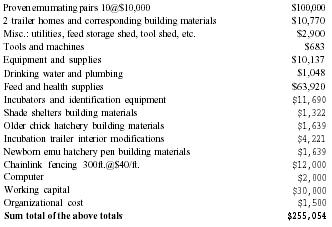
| Proven emu mating pairs 10@$10,000 | $100,000 |
| 2 trailer homes and corresponding building materials | $10,770 |
| Misc.: utilities, feed storage shed, tool shed, etc. | $2,900 |
| Tools and machines | $683 |
| Equipment and supplies | $10,137 |
| Drinking water and plumbing | $1,048 |
| Feed and health supplies | $63,920 |
| Incubators and identification equipment | $11,690 |
| Shade shelters building materials | $1,322 |
| Older chick hatchery building materials | $1,639 |
| Incubation trailer interior modifications | $4,221 |
| Newborn emu hatchery pen building materials | $1,639 |
| Chainlink fencing 300ft.@$40/ft. | $12,000 |
| Computer | $2,000 |
| Working capital | $30,000 |
| Organizational cost | $1,500 |
| Sum total of the above totals | $255,054 |
STRATEGIC PLAN
The emu ranch will initially start with ten proven breeding pairs. Each pair will produce on average between thirty-five to fifty eggs, within the first emu mating season of the first year of operation. The total number of fertile eggs after the first mating season will be between three hundred fifty and five hundred eggs.
With a given 5% loss of successfully hatched chicks to adult emus, the total number of adult emus expected within the first two years will be between three hundred thirty-two and four hundred seventy-five adult birds.
Five emu mating pairs will be added to the ranch inventory after the first two years. After which, five emu mating pairs will be added to the ranch inventory each year. This will leave between three hundred twenty-two and four hundred sixty-five emus as mating pairs. Those birds that are not sold as mating pairs will be sold to the slaughter market, after the first two years.
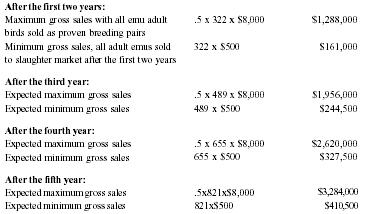
| After the first two years: | ||
| Maximum gross sales with all emu adult birds sold as proven breeding pairs | .5 × 322 × $8,000 | $1,288,000 |
| Minimum gross sales, all adult emus sold to slaughter market after the first two years | 322 × $500 | $161,000 |
| After the third year: | ||
| Expected maximum gross sales | .5 × 489 × $8,000 | $1,956,000 |
| Expected minimum gross sales | 489 × $500 | $244,500 |
| After the fourth year: | ||
| Expected maximum gross sales | .5 × 655 × $8,000 | $2,620,000 |
| Expected minimum gross sales | 655 × $500 | $327,500 |
| After the fifth year: | ||
| Expected maximum gross sales | .5 × 821 × $8,000 | $3,284,000 |
| Expected minimum gross sales | 821 × $500 | $410,500 |
FINANCIAL INFORMATION
Operational Costs
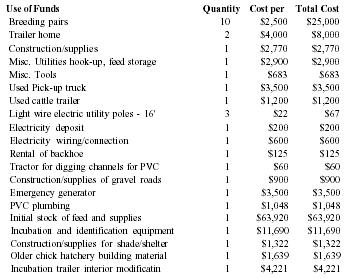
| Use of Funds | Quantity | Cost per | Total Cost |
| Breeding pairs | 10 | $2,500 | $25,000 |
| Trailer home | 2 | $4,000 | $8,000 |
| Construction/supplies | 1 | $2,770 | $2,770 |
| Misc. Utilities hook-up, feed storage | 1 | $2,900 | $2,900 |
| Misc. Tools | 1 | $683 | $683 |
| Used Pick-up truck | 1 | $3,500 | $3,500 |
| Used cattle trailer | 1 | $1,200 | $1,200 |
| Light wire electric utility poles - 16' | 3 | $22 | $67 |
| Electricity deposit | 1 | $200 | $200 |
| Electricity wiring/connection | 1 | $600 | $600 |
| Rental of backhoe | 1 | $125 | $125 |
| Tractor for digging channels for PVC | 1 | $60 | $60 |
| Construction/supplies of gravel roads | 1 | $900 | $900 |
| Emergency generator | 1 | $3,500 | $3,500 |
| PVC plumbing | 1 | $1,048 | $1,048 |
| Initial stock of feed and supplies | 1 | $63,920 | $63,920 |
| Incubation and identification equipment | 1 | $11,690 | $11,690 |
| Construction/supplies for shade/shelter | 1 | $1,322 | $1,322 |
| Older chick hatchery building material | 1 | $1,639 | $1,639 |
| Incubation trailer interior modificatin | 1 | $4,221 | $4,221 |

| New-born emu hatchery pens | 1 | $1,209 | $1,209 |
| Fencing | 300 | $40 | $12,000 |
| Computer system | 1 | $2,000 | $2,000 |
| Working capital | 1 | $126,855 | $126,855 |
| Organization cost | 1 | $1,500 | $1,500 |
| Total | $276,909 |
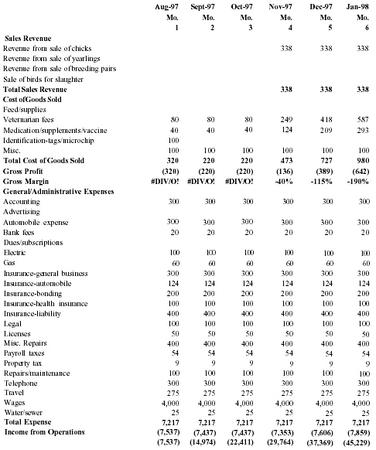
| Projected Income Statement Year One | ||||||
|
Aug-97
Mo. 1 |
Sept-97
Mo. 2 |
Oct-97
Mo. 3 |
Nov-97
Mo. 4 |
Dec-97
Mo. 5 |
Jan-98
Mo. 6 |
|
| Sales Revenue | ||||||
| Revenue from sale of chicks | 338 | 338 | 338 | |||
| Revenue from sale of yearlings | ||||||
| Revenue from sale of breeding pairs | ||||||
| Sale of birds for slaughter | ||||||
| Total Sales Revenue | 338 | 338 | 338 | |||
| Cost of Goods Sold | ||||||
| Feed/supplies | ||||||
| Veternarian fees | 80 | 80 | 80 | 249 | 418 | 587 |
| Medication/supplements/vaccine | 40 | 40 | 40 | 124 | 209 | 293 |
| Identification-tags/microchip | 100 | |||||
| Misc. | 100 | 100 | 100 | 100 | 100 | 100 |
| Total Cost of Goods Sold | 320 | 220 | 220 | 473 | 727 | 980 |
| Gross Profit | (320) | (220) | (220) | (136) | (389) | (642) |
| Gross Margin | #DIV/O! | #DIV/O! | #DIV/O! | −40% | −115% | −190% |
| General/Administrative Expenses | ||||||
| Accounting | 300 | 300 | 300 | 300 | 300 | 300 |
| Advertising | ||||||
| Automobile expense | 300 | 300 | 300 | 300 | 300 | 300 |
| Bank fees | 20 | 20 | 20 | 20 | 20 | 20 |
| Dues/subscriptions | ||||||
| Electric | 100 | 100 | 100 | 100 | 100 | 100 |
| Gas | 60 | 60 | 60 | 60 | 60 | 60 |
| Insurance-general business | 300 | 300 | 300 | 300 | 300 | 300 |
| Insurance-automobile | 124 | 124 | 124 | 124 | 124 | 124 |
| Insurance-bonding | 200 | 200 | 200 | 200 | 200 | 200 |
| Insurance-health insurance | 100 | 100 | 100 | 100 | 100 | 100 |
| Insurance-liability | 400 | 400 | 400 | 400 | 400 | 400 |
| Legal | 100 | 100 | 100 | 100 | 100 | 100 |
| Licenses | 50 | 50 | 50 | 50 | 50 | 50 |
| Misc. Repairs | 400 | 400 | 400 | 400 | 400 | 400 |
| Payroll taxes | 54 | 54 | 54 | 54 | 54 | 54 |
| Property tax | 9 | 9 | 9 | 9 | 9 | 9 |
| Repairs/maintenance | 100 | 100 | 100 | 100 | 100 | 100 |
| Telephone | 300 | 300 | 300 | 300 | 300 | 300 |
| Travel | 275 | 275 | 275 | 275 | 275 | 275 |
| Wages | 4,000 | 4,000 | 4,000 | 4,000 | 4,000 | 4,000 |
| Water/sewer | 25 | 25 | 25 | 25 | 25 | 25 |
| Total Expense | 7,217 | 7,217 | 7,217 | 7,217 | 7,217 | 7,217 |
| Income from Operations | (7,537) | (7,437) | (7,437) | (7,353) | (7,606) | (7,859) |
| (7,537) | (14,974) | (22,411) | (29,764) | (37,369) | (45,229) | |
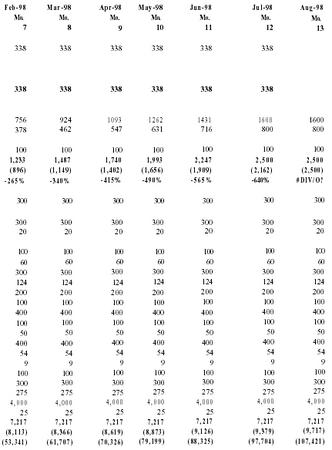
|
Feb-98
Mo. 7 |
Mar-98
Mo. 8 |
Apr-98
Mo. 9 |
May-98
Mo. 10 |
Jun-98
Mo. 11 |
Jul-98
Mo. 12 |
Aug-98
Mo. 13 |
| 338 | 338 | 338 | 338 | 338 | 338 | |
| 338 | 338 | 338 | 338 | 338 | 338 | |
| 756 | 924 | 1093 | 1262 | 1431 | 1600 | 1600 |
| 378 | 462 | 547 | 631 | 716 | 800 | 800 |
| 100 | 100 | 100 | 100 | 100 | 100 | 100 |
| 1,233 | 1,487 | 1,740 | 1,993 | 2,247 | 2,500 | 2,500 |
| (896) | (1,149) | (1,402) | (1,656) | (1,909) | (2,162) | (2,500) |
| −265% | −340% | −415% | −490% | −565% | −640% | #DIV/O! |
| 300 | 300 | 300 | 300 | 300 | 300 | 300 |
| 300 | 300 | 300 | 300 | 300 | 300 | 300 |
| 20 | 20 | 20 | 20 | 20 | 20 | 20 |
| 100 | 100 | 100 | 100 | 100 | 100 | 100 |
| 60 | 60 | 60 | 60 | 60 | 60 | 60 |
| 300 | 300 | 300 | 300 | 300 | 300 | 300 |
| 124 | 124 | 124 | 124 | 124 | 124 | 124 |
| 200 | 200 | 200 | 200 | 200 | 200 | 200 |
| 100 | 100 | 100 | 100 | 100 | 100 | 100 |
| 400 | 400 | 400 | 400 | 400 | 400 | 400 |
| 100 | 100 | 100 | 100 | 100 | 100 | 100 |
| 50 | 50 | 50 | 50 | 50 | 50 | 50 |
| 400 | 400 | 400 | 400 | 400 | 400 | 400 |
| 54 | 54 | 54 | 54 | 54 | 54 | 54 |
| 9 | 9 | 9 | 9 | 9 | 9 | 9 |
| 100 | 100 | 100 | 100 | 100 | 100 | 100 |
| 300 | 300 | 300 | 300 | 300 | 300 | 300 |
| 275 | 275 | 275 | 275 | 275 | 275 | 275 |
| 4,000 | 4,000 | 4,000 | 4,000 | 4,000 | 4,000 | 4,000 |
| 25 | 25 | 25 | 25 | 25 | 25 | 25 |
| 7,217 | 7,217 | 7,217 | 7,217 | 7,217 | 7,217 | 7,217 |
| (8,113) | (8,366) | (8,619) | (8,873) | (9,126) | (9,379) | (9,717) |
| (53,341) | (61,707) | (70,326) | (79,199) | (88,325) | (97,704) | (107,421) |
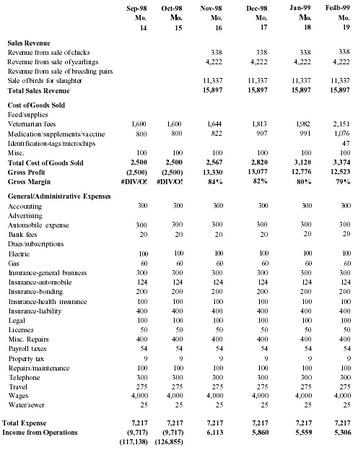
| Projected Income Statement Year Two | ||||||
|
Sep-98
Mo. 14 |
Oct-98
Mo. 15 |
Nov-98
Mo. 16 |
Dec-98
Mo. 17 |
Jan-99
Mo. 18 |
Fe4b-99
Mo. 19 |
|
| Sales Revenue | ||||||
| Revenue from sale of chicks | 338 | 338 | 338 | 338 | ||
| Revenue from sale of yearlings | 4,222 | 4,222 | 4,222 | 4,222 | ||
| Revenue from sale of breeding pairs | ||||||
| Sale of birds for slaughter | 11,337 | 11,337 | 11,337 | 11,337 | ||
| Total Sales Revenue | 15,897 | 15,897 | 15,897 | 15,897 | ||
| Cost of Goods Sold | ||||||
| Feed/supplies | ||||||
| Veternarian fees | 1,600 | 1,600 | 1,644 | 1,813 | 1,982 | 2,151 |
| Medication/supplements/vaccine | 800 | 800 | 822 | 907 | 991 | 1,076 |
| Identification-tags/microchips | 47 | |||||
| Misc. | 100 | 100 | 100 | 100 | 100 | 100 |
| Total Cost of Goods Sold | 2,500 | 2,500 | 2,567 | 2,820 | 3,120 | 3,374 |
| Gross Profit | (2,500) | (2,500) | 13,330 | 13,077 | 12,776 | 12,523 |
| Gross Margin | #DIV/O! | #DIV/O! | 84% | 82% | 80% | 79% |
| General/Administrative Expenses | ||||||
| Accounting | 300 | 300 | 300 | 300 | 300 | 300 |
| Advertising | ||||||
| Automobile expense | 300 | 300 | 300 | 300 | 300 | 300 |
| Bank fees | 20 | 20 | 20 | 20 | 20 | 20 |
| Dues/subscriptions | ||||||
| Electric | 100 | 100 | 100 | 100 | 100 | 100 |
| Gas | 60 | 60 | 60 | 60 | 60 | 60 |
| Insurance-general business | 300 | 300 | 300 | 300 | 300 | 300 |
| Insurance-automobile | 124 | 124 | 124 | 124 | 124 | 124 |
| Insurance-bonding | 200 | 200 | 200 | 200 | 200 | 200 |
| Insurance-health insurance | 100 | 100 | 100 | 100 | 100 | 100 |
| Insurance-liability | 400 | 400 | 400 | 400 | 400 | 400 |
| Legal | 100 | 100 | 100 | 100 | 100 | 100 |
| Licenses | 50 | 50 | 50 | 50 | 50 | 50 |
| Misc. Repairs | 400 | 400 | 400 | 400 | 400 | 400 |
| Payroll taxes | 54 | 54 | 54 | 54 | 54 | 54 |
| Property tax | 9 | 9 | 9 | 9 | 9 | 9 |
| Repairs/maintenance | 100 | 100 | 100 | 100 | 100 | 100 |
| Telephone | 300 | 300 | 300 | 300 | 300 | 300 |
| Travel | 275 | 275 | 275 | 275 | 275 | 275 |
| Wages | 4,000 | 4,000 | 4,000 | 4,000 | 4,000 | 4,000 |
| Water/sewer | 25 | 25 | 25 | 25 | 25 | 25 |
| Total Expense | 7,217 | 7,217 | 7,217 | 7,217 | 7,217 | 7,217 |
| Income from Operations | (9,717) | (9,717) | 6,113 | 5,860 | 5,559 | 5,306 |
| (117,138) | (126,855) | |||||
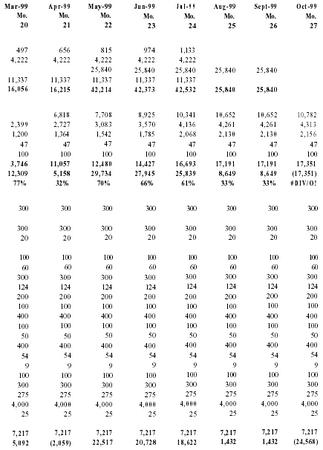
|
Mar-99
Mo. 20 |
Apr-99
Mo. 21 |
May-99
Mo. 22 |
Jun-99
Mo. 23 |
Jul-99
Mo. 24 |
Aug-99
Mo. 25 |
Sept-99
Mo. 26 |
Oct-99
Mo. 27 |
| 497 | 656 | 815 | 974 | 1,133 | |||
| 4,222 | 4,222 | 4,222 | 4,222 | 4,222 | |||
| 25,840 | 25,840 | 25,840 | 25,840 | 25,840 | |||
| 11,337 | 11,337 | 11,337 | 11,337 | 11,337 | |||
| 16,056 | 16,215 | 42,214 | 42,373 | 42,532 | 25,840 | 25,840 | |
| 6,818 | 7,708 | 8,925 | 10,341 | 10,652 | 10,652 | 10,782 | |
| 2,399 | 2,727 | 3,083 | 3,570 | 4,136 | 4,261 | 4,261 | 4,313 |
| 1,200 | 1,364 | 1,542 | 1,785 | 2,068 | 2,130 | 2,130 | 2,156 |
| 47 | 47 | 47 | 47 | 47 | 47 | 47 | 47 |
| 100 | 100 | 100 | 100 | 100 | 100 | 100 | 100 |
| 3,746 | 11,057 | 12,480 | 14,427 | 16,693 | 17,191 | 17,191 | 17,351 |
| 12,309 | 5,158 | 29,734 | 27,945 | 25,839 | 8,649 | 8,649 | (17,351) |
| 77% | 32% | 70% | 66% | 61% | 33% | 33% | #DIV/O! |
| 300 | 300 | 300 | 300 | 300 | 300 | 300 | 300 |
| 300 | 300 | 300 | 300 | 300 | 300 | 300 | 300 |
| 20 | 20 | 20 | 20 | 20 | 20 | 20 | 20 |
| 100 | 100 | 100 | 100 | 100 | 100 | 100 | 100 |
| 60 | 60 | 60 | 60 | 60 | 60 | 60 | 60 |
| 300 | 300 | 300 | 300 | 300 | 300 | 300 | 300 |
| 124 | 124 | 124 | 124 | 124 | 124 | 124 | 124 |
| 200 | 200 | 200 | 200 | 200 | 200 | 200 | 200 |
| 100 | 100 | 100 | 100 | 100 | 100 | 100 | 100 |
| 400 | 400 | 400 | 400 | 400 | 400 | 400 | 400 |
| 100 | 100 | 100 | 100 | 100 | 100 | 100 | 100 |
| 50 | 50 | 50 | 50 | 50 | 50 | 50 | 50 |
| 400 | 400 | 400 | 400 | 400 | 400 | 400 | 400 |
| 54 | 54 | 54 | 54 | 54 | 54 | 54 | 54 |
| 9 | 9 | 9 | 9 | 9 | 9 | 9 | 9 |
| 100 | 100 | 100 | 100 | 100 | 100 | 100 | 100 |
| 300 | 300 | 300 | 300 | 300 | 300 | 300 | 300 |
| 275 | 275 | 275 | 275 | 275 | 275 | 275 | 275 |
| 4,000 | 4,000 | 4,000 | 4,000 | 4,000 | 4,000 | 4,000 | 4,000 |
| 25 | 25 | 25 | 25 | 25 | 25 | 25 | 25 |
| 7,217 | 7,217 | 7,217 | 7,217 | 7,217 | 7,217 | 7,217 | 7,217 |
| 5,092 | (2,059) | 22,517 | 20,728 | 18,622 | 1,432 | 1,432 | (24,568) |
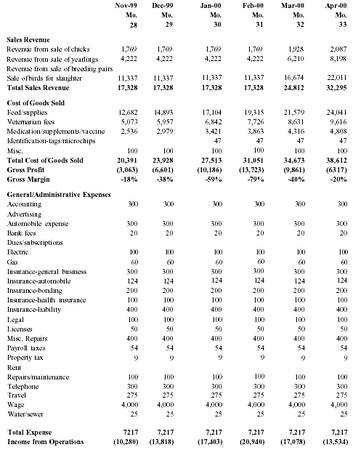
| Projected Income Statement Year Three | ||||||
|
Nov-99
Mo. 28 |
Dec-99
Mo. 29 |
Jan-00
Mo. 30 |
Feb-00
Mo. 31 |
Mar-00
Mo. 32 |
Apr-00
Mo. 33 |
|
| Sales Revenue | ||||||
| Revenue from sale of chicks | 1,769 | 1,769 | 1,769 | 1,769 | 1,928 | 2,087 |
| Revenue from sale of yearlings | 4,222 | 4,222 | 4,222 | 4,222 | 6,210 | 8,198 |
| Revenue from sale of breeding pairs | ||||||
| Sale of birds for slaughter | 11,337 | 11,337 | 11,337 | 11,337 | 16,674 | 22,011 |
| Total Sales Revenue | 17,328 | 17,328 | 17,328 | 17,328 | 24,812 | 32,295 |
| Cost of Goods Sold | ||||||
| Feed/supplies | 12,682 | 14,893 | 17,104 | 19,315 | 21,579 | 24,041 |
| Veternarian fees | 5,073 | 5,957 | 6,842 | 7,726 | 8,631 | 9,616 |
| Medication/supplements/vaccine | 2,536 | 2,979 | 3,421 | 3,863 | 4,316 | 4,808 |
| Identification-tags/microchips | 47 | 47 | 47 | 47 | ||
| Misc. | 100 | 100 | 100 | 100 | 100 | 100 |
| Total Cost of Goods Sold | 20,391 | 23,928 | 27,513 | 31,051 | 34,673 | 38,612 |
| Gross Profit | (3,063) | (6,601) | (10,186) | (13,723) | (9,861) | (6,317) |
| Gross Margin | −18% | −38% | −59% | −79% | −40% | −20% |
| General/Administrative Expenses | ||||||
| Accounting | 300 | 300 | 300 | 300 | 300 | 300 |
| Advertising | ||||||
| Automobile expense | 300 | 300 | 300 | 300 | 300 | 300 |
| Bank fees | 20 | 20 | 20 | 20 | 20 | 20 |
| Dues/subscriptions | ||||||
| Electric | 100 | 100 | 100 | 100 | 100 | 100 |
| Gas | 60 | 60 | 60 | 60 | 60 | 60 |
| Insurance-general business | 300 | 300 | 300 | 300 | 300 | 300 |
| Insurance-automobile | 124 | 124 | 124 | 124 | 124 | 124 |
| Insurance-bonding | 200 | 200 | 200 | 200 | 200 | 200 |
| Insurance-health insurance | 100 | 100 | 100 | 100 | 100 | 100 |
| Insurance-liability | 400 | 400 | 400 | 400 | 400 | 400 |
| Legal | 100 | 100 | 100 | 100 | 100 | 100 |
| Licenses | 50 | 50 | 50 | 50 | 50 | 50 |
| Misc. Repairs | 400 | 400 | 400 | 400 | 400 | 400 |
| Payroll taxes | 54 | 54 | 54 | 54 | 54 | 54 |
| Property tax | 9 | 9 | 9 | 9 | 9 | 9 |
| Rent | ||||||
| Repairs/maintenance | 100 | 100 | 100 | 100 | 100 | 100 |
| Telephone | 300 | 300 | 300 | 300 | 300 | 300 |
| Travel | 275 | 275 | 275 | 275 | 275 | 275 |
| Wage | 4,000 | 4,000 | 4,000 | 4,000 | 4,000 | 4,000 |
| Water/sewer | 25 | 25 | 25 | 25 | 25 | 25 |
| Total Expense | 7217 | 7,217 | 7,217 | 7,217 | 7,217 | 7,217 |
| Income from Operations | (10,280) | (13,818) | (17,403) | (20,940) | (17,078) | (13,534) |
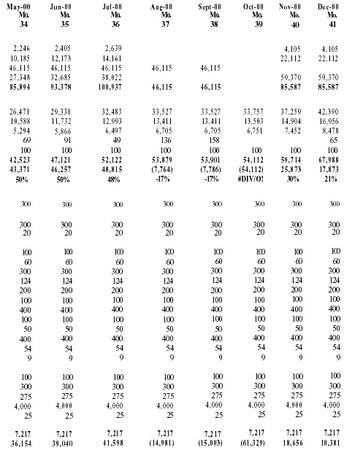
|
May-00
Mo. 34 |
Jun-00
Mo. 35 |
Jul-00
Mo. 36 |
Aug-00
Mo. 37 |
Sept-00
Mo. 38 |
Oct-00
Mo. 39 |
Nov-00
Mo. 40 |
Dec-00
Mo. 41 |
| 2,246 | 2,405 | 2,639 | 4,105 | 4,105 | |||
| 10,185 | 12,173 | 14,161 | 22,112 | 22,112 | |||
| 46,115 | 46,115 | 46,115 | 46,115 | 46,115 | |||
| 27,348 | 32,685 | 38,022 | 59,370 | 59,370 | |||
| 85,894 | 93,378 | 100,937 | 46,115 | 46,115 | 85,587 | 85,587 | |
| 26,471 | 29,331 | 32,483 | 33,527 | 33,527 | 33,757 | 37,259 | 42,390 |
| 10,588 | 11,732 | 12,993 | 13,411 | 13,411 | 13,503 | 14,904 | 16,956 |
| 5,294 | 5,866 | 6,497 | 6,705 | 6,705 | 6,751 | 7,452 | 8,478 |
| 69 | 91 | 49 | 136 | 158 | 65 | ||
| 100 | 100 | 100 | 100 | 100 | 100 | 100 | 100 |
| 42,523 | 47,121 | 52,122 | 53,879 | 53,901 | 54,112 | 59,714 | 67,988 |
| 43,371 | 46,257 | 48,815 | (7,764) | (7,786) | (54,112) | 25,873 | 17,873 |
| 50% | 50% | 48% | −17% | −17% | #DIV/O! | 30% | 21% |
| 300 | 300 | 300 | 300 | 300 | 300 | 300 | 300 |
| 300 | 300 | 300 | 300 | 300 | 300 | 300 | 300 |
| 20 | 20 | 20 | 20 | 20 | 20 | 20 | 20 |
| 100 | 100 | 100 | 100 | 100 | 100 | 100 | 100 |
| 60 | 60 | 60 | 60 | 60 | 60 | 60 | 60 |
| 300 | 300 | 300 | 300 | 300 | 300 | 300 | 300 |
| 124 | 124 | 124 | 124 | 124 | 124 | 124 | 124 |
| 200 | 200 | 200 | 200 | 200 | 200 | 200 | 200 |
| 100 | 100 | 100 | 100 | 100 | 100 | 100 | 100 |
| 400 | 400 | 400 | 400 | 400 | 400 | 400 | 400 |
| 100 | 100 | 100 | 100 | 100 | 100 | 100 | 100 |
| 50 | 50 | 50 | 50 | 50 | 50 | 50 | 50 |
| 400 | 400 | 400 | 400 | 400 | 400 | 400 | 400 |
| 54 | 54 | 54 | 54 | 54 | 54 | 54 | 54 |
| 9 | 9 | 9 | 9 | 9 | 9 | 9 | 9 |
| 100 | 100 | 100 | 100 | 100 | 100 | 100 | 100 |
| 300 | 300 | 300 | 300 | 300 | 300 | 300 | 300 |
| 275 | 275 | 275 | 275 | 275 | 275 | 275 | 275 |
| 4,000 | 4,000 | 4,000 | 4,000 | 4,000 | 4,000 | 4,000 | 4,000 |
| 25 | 25 | 25 | 25 | 25 | 25 | 25 | 25 |
| 7,217 | 7,217 | 7,217 | 7,217 | 7,217 | 7,217 | 7,217 | 7,217 |
| 36,154 | 39,040 | 41,598 | (14,981) | (15,003) | (61,329) | 18,656 | 10,381 |
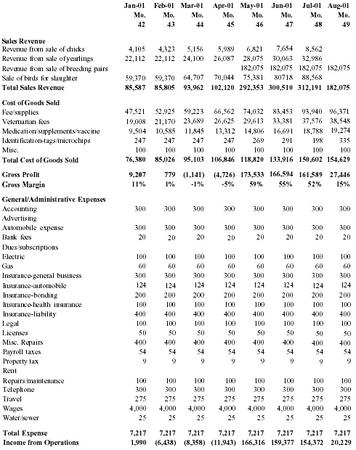
| Projected Income Statement Future | ||||||||
|
Jan-01
Mo. 42 |
Feb-01
Mo. 43 |
Mar-01
Mo. 44 |
Apr-01
Mo. 45 |
May-01
Mo. 46 |
Jun-01
Mo. 47 |
Jul-01
Mo. 48 |
Aug-01
Mo. 49 |
|
| Sales Revenue | ||||||||
| Revenue from sale of chicks | 4,105 | 4,323 | 5,156 | 5,989 | 6,821 | 7,654 | 8,562 | |
| Revenue from sale of yearlings | 22,112 | 22,112 | 24,100 | 26,087 | 28,075 | 30,063 | 32,986 | |
| Revenue from sale of breeding pairs | 182,075 | 182,075 | 182,075 | 182,075 | ||||
| Sale of birds for slaughter | 59,370 | 59,370 | 64,707 | 70,044 | 75,381 | 80,718 | 88,568 | |
| Total Sales Revenue | 85,587 | 85,805 | 93,962 | 102,120 | 292,353 | 300,510 | 312,191 | 182,075 |
| Cost of Goods Sold | ||||||||
| Fee/supplies | 47,521 | 52,925 | 59,223 | 66,562 | 74,032 | 83,453 | 93,940 | 96,371 |
| Veternarian fees | 19,008 | 21,170 | 23,689 | 26,625 | 29,613 | 33,381 | 37,576 | 38,548 |
| Medication/supplements/vaccine | 9,504 | 10,585 | 11,845 | 13,312 | 14,806 | 16,691 | 18,788 | 19,274 |
| Identification-tags/microchips | 247 | 247 | 247 | 247 | 269 | 291 | 198 | 335 |
| Misc. | 100 | 100 | 100 | 100 | 100 | 100 | 100 | 100 |
| Total Cost of Goods Sold | 76,380 | 85,026 | 95,103 | 106,846 | 118,820 | 133,916 | 150,602 | 154,629 |
| Gross Profit | 9,207 | 779 | (1,141) | (4,726) | 173,533 | 166,594 | 161,589 | 27,446 |
| Gross Margin | 11% | 1% | −1% | −5% | 59% | 55% | 52% | 15% |
| General/Administrative Expenses | ||||||||
| Accounting | 300 | 300 | 300 | 300 | 300 | 300 | 300 | 300 |
| Advertising | ||||||||
| Automobile expense | 300 | 300 | 300 | 300 | 300 | 300 | 300 | 300 |
| Bank fees | 20 | 20 | 20 | 20 | 20 | 20 | 20 | 20 |
| Dues/subscriptions | ||||||||
| Electric | 100 | 100 | 100 | 100 | 100 | 100 | 100 | 100 |
| Gas | 60 | 60 | 60 | 60 | 60 | 60 | 60 | 60 |
| Insurance-general business | 300 | 300 | 300 | 300 | 300 | 300 | 300 | 300 |
| Insurance-automobile | 124 | 124 | 124 | 124 | 124 | 124 | 124 | 124 |
| Insurance-bonding | 200 | 200 | 200 | 200 | 200 | 200 | 200 | 200 |
| Insurance-health insurance | 100 | 100 | 100 | 100 | 100 | 100 | 100 | 100 |
| Insurance-liability | 400 | 400 | 400 | 400 | 400 | 400 | 400 | 400 |
| Legal | 100 | 100 | 100 | 100 | 100 | 100 | 100 | 100 |
| Licenses | 50 | 50 | 50 | 50 | 50 | 50 | 50 | 50 |
| Misc. Repairs | 400 | 400 | 400 | 400 | 400 | 400 | 400 | 400 |
| Payroll taxes | 54 | 54 | 54 | 54 | 54 | 54 | 54 | 54 |
| Property tax | 9 | 9 | 9 | 9 | 9 | 9 | 9 | 9 |
| Rent | ||||||||
| Repairs/maintenance | 100 | 100 | 100 | 100 | 100 | 100 | 100 | 100 |
| Telephone | 300 | 300 | 300 | 300 | 300 | 300 | 300 | 300 |
| Travel | 275 | 275 | 275 | 275 | 275 | 275 | 275 | 275 |
| Wages | 4,000 | 4,000 | 4,000 | 4,000 | 4,000 | 4,000 | 4,000 | 4,000 |
| Water/sewer | 25 | 25 | 25 | 25 | 25 | 25 | 25 | 25 |
| Total Expense | 7,217 | 7,217 | 7,217 | 7,217 | 7,217 | 7,217 | 7,217 | 7,217 |
| Income from Operations | 1,990 | (6,438) | (8,358) | (11,943) | 166,316 | 159,377 | 154,372 | 20,229 |
Comment about this article, ask questions, or add new information about this topic: